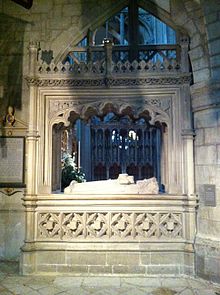
Oswald was King of Northumbria from 634 until his death, and is venerated as a saint, of whom there was a particular cult in the Middle Ages.

Mercia was one of the three main Anglic kingdoms founded after Sub-Roman Britain was settled by Anglo-Saxons in an era called the Heptarchy. It was centred on the River Trent and its tributaries, in a region now known as the Midlands of England.

Æthelflæd, Lady of the Mercians ruled Mercia in the English Midlands from 911 until her death. She was the eldest daughter of Alfred the Great, king of the Anglo-Saxon kingdom of Wessex, and his wife Ealhswith.
Oswiu, also known as Oswy or Oswig, was King of Bernicia from 642 and of Northumbria from 654 until his death. He is notable for his role at the Synod of Whitby in 664, which ultimately brought the church in Northumbria into conformity with the wider Catholic Church.

Æthelred was king of Mercia from 675 until 704. He was the son of Penda of Mercia and came to the throne in 675, when his brother, Wulfhere of Mercia, died from an illness. Within a year of his accession he invaded Kent, where his armies destroyed the city of Rochester. In 679 he defeated his brother-in-law, Ecgfrith of Northumbria, at the Battle of the Trent: the battle was a major setback for the Northumbrians, and effectively ended their military involvement in English affairs south of the Humber. It also permanently returned the Kingdom of Lindsey to Mercia's possession. However, Æthelred was unable to re-establish his predecessors' domination of southern Britain.

Wulfhere or Wulfar was King of Mercia from 658 until 675 AD. He was the first Christian king of all of Mercia, though it is not known when or how he converted from Anglo-Saxon paganism. His accession marked the end of Oswiu of Northumbria's overlordship of southern England, and Wulfhere extended his influence over much of that region. His campaigns against the West Saxons led to Mercian control of much of the Thames valley. He conquered the Isle of Wight and the Meon valley and gave them to King Æthelwealh of the South Saxons. He also had influence in Surrey, Essex, and Kent. He married Eormenhild, the daughter of King Eorcenberht of Kent.
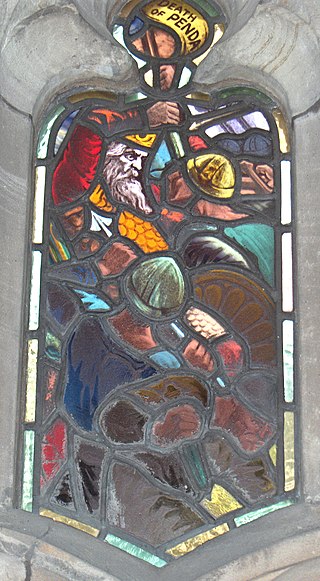
Penda was a 7th-century king of Mercia, the Anglo-Saxon kingdom in what is today the Midlands. A pagan at a time when Christianity was taking hold in many of the Anglo-Saxon kingdoms, Penda took over the Severn Valley in 628 following the Battle of Cirencester before participating in the defeat of the powerful Northumbrian king Edwin at the Battle of Hatfield Chase in 633.
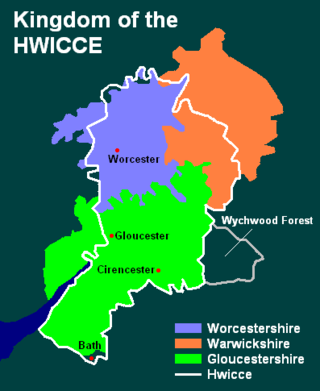
Hwicce was a kingdom in Anglo-Saxon England. According to the Anglo-Saxon Chronicle, the kingdom was established in 577, after the Battle of Deorham. After 628, the kingdom became a client or sub-kingdom of Mercia as a result of the Battle of Cirencester.
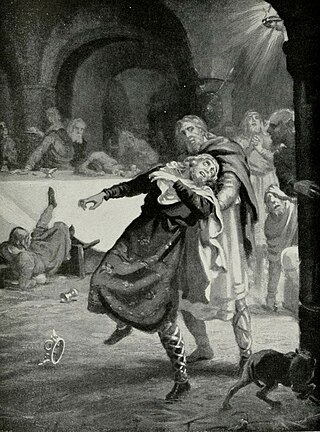
Ceolred was king of Mercia from 709 to 716.
Ælfwine was the King of Deira from 670 to 679. He was a son of Oswiu of Northumbria and a brother of Ecgfrith of Northumbria.

Aldfrith was king of Northumbria from 685 until his death. He is described by early writers such as Bede, Alcuin and Stephen of Ripon as a man of great learning. Some of his works and some letters written to him survive. His reign was relatively peaceful, marred only by disputes with Bishop Wilfrid, a major figure in the early Northumbrian church.
Osthryth, queen of the Mercians, was the wife of King Æthelred and daughter of King Oswiu of Northumbria and his second wife Eanflæd. She probably married Æthelred before 679 and was murdered by the nobles of Mercia.
Eanhere was a possible ruler of Hwicce, one of the Anglo Saxon kingdoms of England, maybe reigning jointly with his brother Eanfrith. His niece, Eanfrith's daughter Eafe, married King Æðelwealh of Sussex. Unfortunately, the sole source of information concerning Eanhere is Bede, who just mentioned his name in passing, and did not actually state that Eanhere was a king:
"Porro regina, nomine Eabae, in sua, id est Huicciorum prouincia fuerat baptizata. Erat autem filia Eanfridi fratris Ænheri, qui ambo cum suo populo Christiani fuere."
Oshere was king of the Hwicce, an Anglo-Saxon tribe occupying land in what later became Gloucestershire and Worcestershire. A member of the royal house of Northumbria, Oshere was a sub-king to Æthelred, king of Mercia.
Æthelheard was the king of Hwicce, he reigned jointly with his presumed brothers Æthelweard, Æthelberht and Æthelric. It is probable that they were all sons of Oshere, although the paternity of Æthelheard and Æthelberht is not explicitly stated in surviving documents.
Æðelweard was the king of Hwicce. He apparently reigned jointly with his presumed brothers Æthelheard, Æthelberht and Æthelric. He was the son of Oshere.
Æthelric was a king of the Hwicce and son of Oshere; it is possible that he reigned jointly with Æthelheard, Æthelweard, and Æthelberht.
Oswald was a brother of Osric, King of Anglo-Saxon kingdom of Hwicce, a sub-kingdom of Mercia in England.
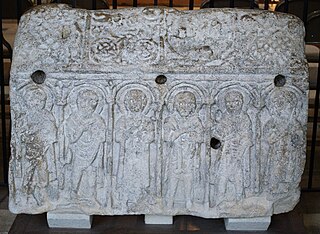
Medeshamstede was the name of Peterborough in the Anglo-Saxon period. It was the site of a monastery founded around the middle of the 7th century, which was an important feature in the kingdom of Mercia from the outset. Little is known of its founder and first abbot, Sexwulf, though he was himself an important figure, and later became bishop of Mercia. Medeshamstede soon acquired a string of daughter churches, and was a centre for an Anglo-Saxon sculptural style.

St Oswald's Priory was founded by Æthelflæd, daughter of Alfred the Great, and her husband Æthelred, ealdorman of Mercia, in the late 880s or the 890s. It appears to have been an exact copy of the Old Minster, Winchester It is a Grade I listed building.
